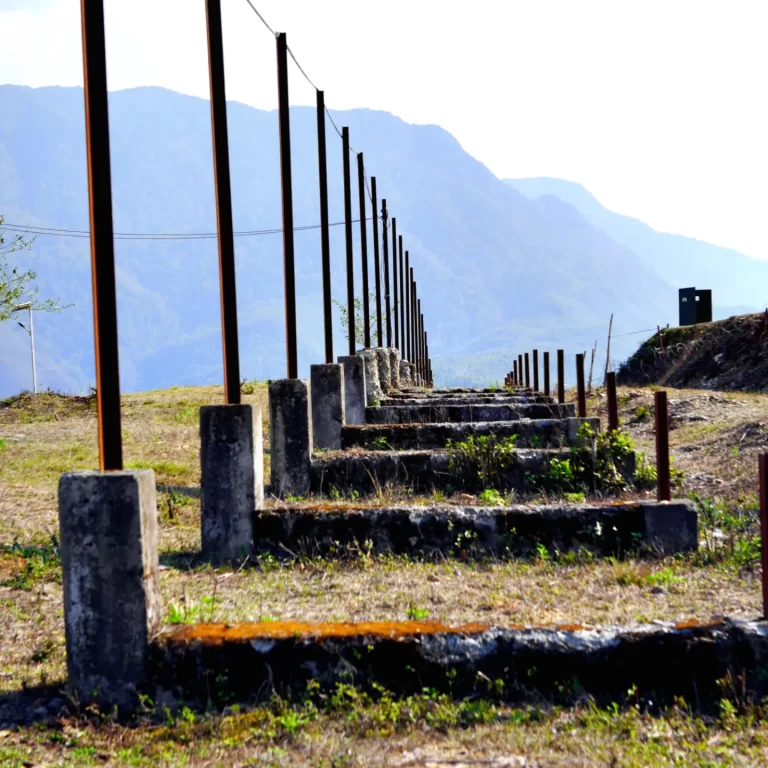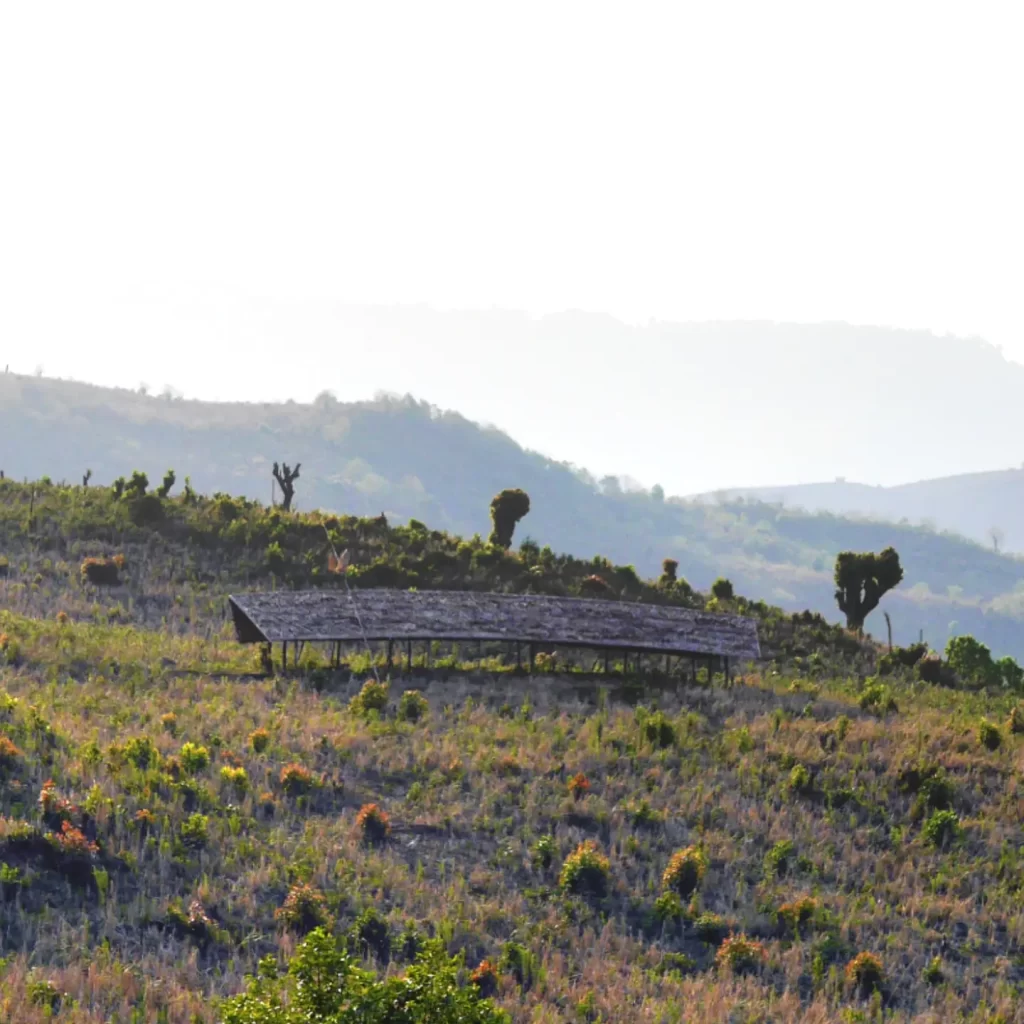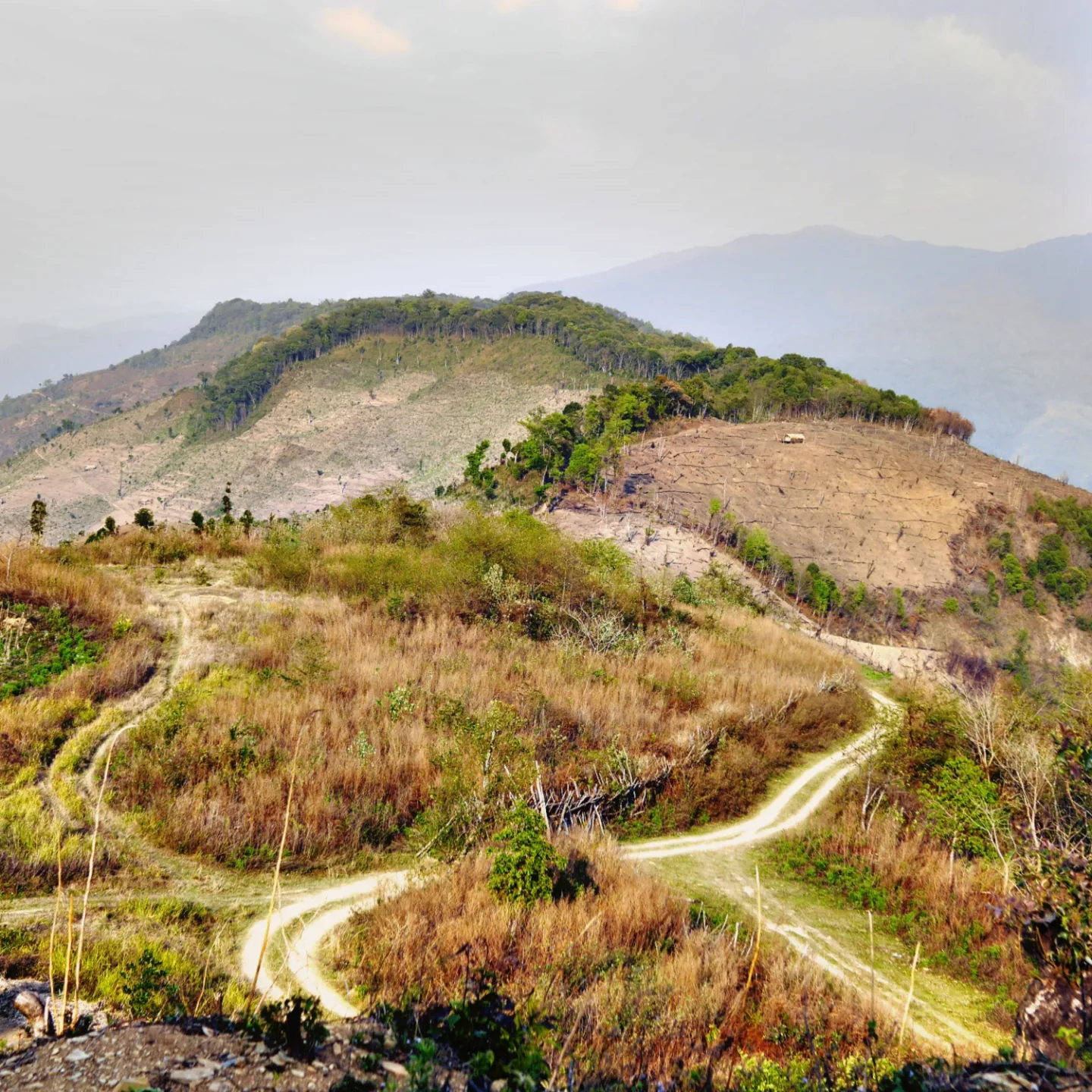In the remote highlands of the North-Eastern region of India and the North-Western part of Myanmar, indigenous Naga communities have been compelled to live in an unimaginable predicament, oscillating between self-determination and a sense of belonging. This blog post is a reflection of my experience during the Earthkeepers’ preliminary fieldwork in Noklak district, Nagaland. It focuses on the complexity of the Indo-Myanmar border and examines what a border is and how it is perceived by the people in the Noklak area.
For a moment, one may be distracted from the grim reality by the captivating landscape and how the indigenous people make use of their natural resources. This region has formidable hills, some of them denuded by jhum fields, which become golden yellow after harvest, differentiated from the speckled green patches of untouched forest. It will not be long before one finds out that the golden yellow fields are in Myanmar, and the farmers from the Indian side of the border harvest from those fields, which is their ancestral land.
An inconvenient division
The Khiamniungan community is divided by the international border in such a way that the majority of the villages are in Myanmar. When a Naga community is divided into two without their consultation, the consequences can be devastating, as the traditions and customs are closely tied to the land and the larger community. Committed to the idea of self-determination, Nagas are in a constant state of contestation with the Indian government. The Eastern Nagas have more facets to their resistance as it involves geopolitics, in which the Indian Border Security Force (BSF) and Assam Rifles constantly get involved for the sake of national security.
On 6th April 2023, Earthkeepers set out to Noklak for their preliminary fieldwork to establish relationships with the communities in the district. Our research is designed in such a way that the community leads us to critical issues related to our inquiry. This exposed us to the daily problems they want outsiders to understand. One of the issues they constantly struggle with is the ‘bordering phenomenon’. For the Khiamniungan community, the border is an invasive structure because it goes against the preexisting social reality.
Visiting Dan village
On our visit to Dan village, we were warmly greeted by villagers who were constructing a guest house. After a lengthy discussion about our research, we were led to the Indo-Myanmar border, where the International Trade Centre is located. This centre has become dysfunctional partly because of the COVID-19 pandemic, which prevented international travel, and the local insurgency, which the villagers claim is the primary cause of the dysfunction. The border personnel were meticulous about checking our backgrounds and intentions, and it is not surprising that our ID cards were temporarily seized before crossing the border. Although we were permitted to cross, we were prohibited from going beyond the one-kilometre mark from the Indian side.
Before we traversed the border, we had tea with the Assam Rifles personnel and casually discussed miscellaneous topics. The first thing we noticed as we approached the camp was an incomplete border construction, abandoned due to a protest by the villagers. Such fierce opposition and resistance against the division of the community by the border indicate a strong bilateral relationship. After all, the border creates a division that the Khiamniungan community will not accept without a fight.

The cross-border community ties are strengthened by bilateral economic relations and transnational political processes such as the Khiamniungan Students’ Union and pan-Naga ideology. It is important to view the border from the community’s perspective, as its creation is not the product of a common consensus but the result of British colonisation. The insensitive colonial border was later adopted by the two state powers without any negotiation with the indigenous community. Hence, today’s porous border is predated by a community sharing a common identity and ancestry.
Another significant detail I observed is how we entered from the Myanmar side of the border to meet the border personnel for tea. As we got to the border camp, there was a fence along the boundary with an entrance simply barricaded by removable bamboo poles inserted horizontally, which could be removed to enter the compound. On the northern side was a shooting range with a slogan written on a board which read “EK GOLI, EK DUSHMAN ”, meaning, “One Bullet, One Enemy”. The other side of the fence was Myanmar, where the jhum fields of the villagers are located. It is not hard to imagine how complicated life would be if one’s land were split into two by an international border, a situation faced daily by the Head Gaonbura of Dan village. This is not an isolated case. There is the well-known instance of the Konyak chief’s house at Longwa, which has been split into Myanmar and India by the border— he literally eats in Myanmar and sleeps in India.

Border theories
The ultimate question is, “What is a border?”. Early studies on borders, conducted mostly by geographers and historians, focused on state borders, and human agency was rarely mentioned. Friedrich Ratzel (1844–1904), a German geographer and ethnographer, is often credited as one of the pioneers of border studies. He combined physical and social elements to construct a holistic framework for understanding borders (Laine, 2015). Later, borders became the focus of multidisciplinary studies involving political scientists, sociologists, anthropologists, linguists, psychologists, economists, and specialists in technical sciences. However, there seem to be limits to the interdisciplinary approach due to the disconnect between empirical studies and theoretical discourse. For this reason, borders are still poorly understood.
Thomas Nail, in his book “Theory of the Border” (2016), developed a theoretical framework that can help us understand the historical conditions that give rise to empirical borders. Introducing kinopolitics, a theory of the movement of flows, he defines borders as the ‘process of social division’. The social movement creates limit junctions, which are perceived as the border we know. From this perspective, the borders cannot be studied as geographical lines between sovereign territories. This can somehow explain the ambiguous nature of the international boundary at Dan. The community has land in another country, which means they have to cross the state boundary daily. The border personnel do not prevent the local people from crossing the border, and neither do they stop those from Myanmar travelling to Noklak in India, hence allowing the local communities unregulated passage to and fro.
Nail also considers the border as ‘in between’, i.e., belonging to neither of the two states, which is an apt description of the unregistered bikes the border community uses for commercial activities. In fact, most border villages in Nagaland are nearer to major towns in Myanmar than they are to Kohima (Nagaland’s capital). As a result, they depend more on Myanmar for trade than on the Indian market. When we were taken across the border, the villagers guided us to historical WWII sites located on their land. If these places were converted into tourist spots, they could be interesting attractions.
The imposed border has an immense impact on the borderland communities. It is thus unfeasible to conceive a discrete existence of two sovereign states separated by a border in such a situation. Unless one has experienced bordering, it is hard to imagine living in a space where there is a constant state of contestation with the state powers to live in one’s ancestral land. One of the problems with imposed borders in this region is the disconnect of the modern border with the perception of time and space by the indigenous communities. This results in the development of ‘mechanisms to resist, negotiate and sometimes even evade the state and its agencies’ (Ketoukhrie-ü, 2023). For this reason, the states must include the voice of the borderland communities in their policies and ensure their rights, safety, and protection, as people will find ways to defy the state if they are compelled to do so by circumstances. Moreover, the North East is a sensitive region, where conflicts on every side torment the indigenous people who inhabit the territorial frontier under the Act East Policy.
References
Ketoukhrie-ü. (2023). Imposed Geography and Contested Spaces Among Borderland Communities in the Indo-Myanmar Borderland: The Case of Konyak Nagas and Khiamniungan Nagas. India Quarterly, 79(1), 45–62.
Laine, J. P. (2015). A historical view on the study of borders. In Sevastianov, S. V., J. Laine & A. Kireev (Eds). Introduction to Borders (14-32). Vladivostok: Dalnauka.
Nail, T. (2016). Theory of the Border. New York: Oxford University Press.
Bothered by the Border
By Tümüzo Katiry.


